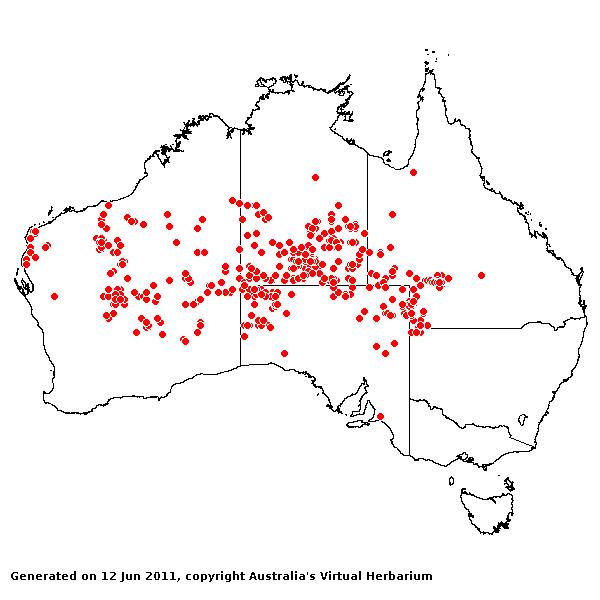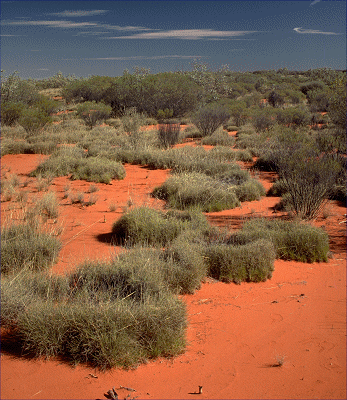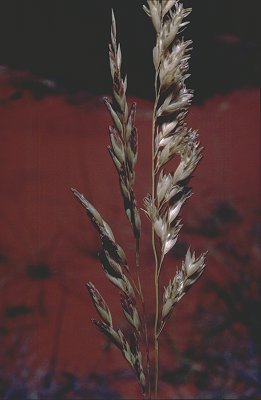Triodia basedowii E.Pritzel. Repert.
Spec.. Regni Veg. 15: 356 (1918).
Classification. (GPWG 2001) : Subfamily
Chloridoideae. Triodeae.
Type of Basionym or
Protologue Information: ST: H. Basedow 315, 1903, Northern
Territory; Central Australia; Elder Exploring Expedition, Arkaringa Creek. ST: H.
Basedow 425, 1903, Northern Terrritory; Central Australia; Elder Exploring
Expedition, Arkaringa Creek. (K, NSW).
Key references
(books and floras): [1952] C.A.Gardner, Flora of Western Australia 1
Gramineae (67), [1981] M.Lazarides in J.Jessop (ed)., Flora of
Central Australia (444), [2002] D.Sharp & B.K.Simon, AusGrass,
Grasses of Australia, [2006] J.Jessop, G.R.M.Dashorst, F.M.James, Grasses
of South Australia (410), [2008] S.W.L.Jacobs, R.D.B.Walley &
D.J.B.Wheeler, Grasses of New South Wales (387).
Illustrations:
[1952] C.A.Gardner, Flora of Western Australia 1 Gramineae (69,
Pl. 19), [2006] J.Jessop, G.R.M.Dashorst, F.M.James, Grasses of South
Australia (411, fig. 339), [2008]
S.W.L.Jacobs, R.D.B.Whalley & D.J.B.Wheeler, Grasses of New South Wales,
4th edn (387).
Habit.
Perennial. Stolons present. Culms 15–130 cm tall. Leaf-sheaths hairy.
Leaf-sheath auricles absent. Ligule a fringe of hairs. Leaf-blades straight,
aciculate, conduplicate, (2–)5–25 cm long, 0.7 mm wide.
Inflorescence.
Inflorescence compound, a panicle. Panicle linear, (3–)6–13(–16) cm long, 1–1.5
cm wide.
Spikelets.
Spikelets pedicelled. Fertile spikelets many flowered, with at least 2 fertile
florets (5–6), comprising 5–6 fertile floret(s), with diminished florets at the
apex, oblong, laterally compressed, 7–18 mm long.
Glumes. Glumes
similar, thinner than fertile lemma. Lower glume oblong, scarious, without
keels, 7–13 -nerved. Lower glume apex muticous or mucronate. Upper glume
oblong, (4–)6–10 mm long, scarious, without keels, 7–13 -nerved. Upper glume
apex entire, muticous or mucronate.
Florets.
Fertile lemma 5.5–9 mm long, without keel or keeled, 9–15 -nerved. Lemma
surface indumented. Lemma apex lobed. Anthers 3.
Continental
Distribution: Australasia.
Australian
Distribution: Western Australia, Northern Territory, South Australia,
Queensland, New South Wales.
Western Australia:
Canning, Keartland, Carnegie, Helms, Fortescue, Ashburton, Carnarvon, Austin.
Eucla. Northern Territory: Barkly Tableland, Central Australia North,
Central Australia South. South Australia: North-western, Lake Eyre,
Nullabor, Flinders Ranges. Queensland: Burke, Gregory North, Gregory
South, Mitchell. New South Wales: North Far Western Plains.
Notes.
The deeply lobed bitextured lemma; bitextured mostly glabrous, long palea;
many-nerved scarious usually glabrous glumes long relative to spikelet; linear
usually short and dense panicle, and usually woolly indumentum are diagnostic
features.
Between
19°S and 30°S in W.A., S of 18°S in N.T., northern S.A., NW N.S.W., and western
and central Qld. Chiefly on flat to gently sloping and undulating sandplains,
dunefields, dune swales and sandhills in deep, red or reddish-yellow, siliceous
sands and sandy loams; less commonly in shallow, rocky or pebbly or gravelly
soils, clayey loams or clayey sands, on small hills, lateritic rises and in
association with limestone; also in skeletal soil on quartzite hills and
outcrops, sandy valleys in quartzite ranges, creek frontages, and on sand dune
on edge of salt lake; flowers all seasons.





